|
Here are all the paintings of Blake, William 01
| ID |
Painting |
Oil Pantings, Sorted from A to Z |
Painting Description |
| 96874 |
 |
A Wreath of Flowers |
1884(1884)
Medium oil on canvas
Dimensions 122.5 X 142.7 cm
cyf |
| 21942 |
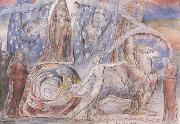 |
Beatrice addressing Dante from her Wagon (mk08) |
c.1842-1826
Aquarell,36.5X52CM
London,Tate Gallery |
| 62542 |
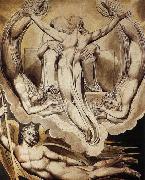 |
Christ as the Redeemer of Man |
1808 Pen and watercolour, 496 x 393 mm Museum of Fine Arts, Boston Blake's visionary drawing style is demonstrated in this illustration to Milton's Paradise Lost, III. Christ floats in the air before God the Father, the position of his body referring to his death on the cross. The expressive, outsized hands of his father touch him lightly. Four angels accompany Christ on his way to EEarth. The unremitting movement contains tension. Even in terms of colour the divine realm is divided from the void, in which Satan, armed with a spear, attempts to prevent God's plan of redemption for the world. The scene is characterized by symmetry and repetition, and is not only illuminated by the artist's technique, but is also enlightened spiritually. Author: BLAKE, William Title: Christ as the Redeemer of Man Form: graphics , 1751-1800 , English , religious |
| 10786 |
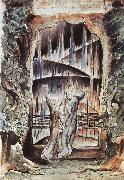 |
Dante and Virgil at the Gates of Hell |
|
| 62543 |
 |
Elisha in the Chamber on the Wall |
1820 Sepia wash over pencil, 243 x 210 mm Tate Gallery, London Among Blake's metaphors for creative vision was the Old Testament prophet Elisha, foretelling her future son to the Shunammite woman who had given him a room for his meditations. There can be little doubt that Blake's bearded seer in his chamber was a more revealing record of himself and his art than a literal portrayal of his features could ever be. Author: BLAKE, William Title: Elisha in the Chamber on the Wall Form: graphics , 1751-1800 , English , religious |
| 10785 |
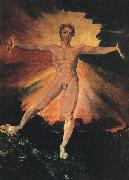 |
Glad Day |
|
| 10789 |
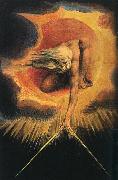 |
God as an Architect |
illustration from The Ancient of Days, 1794 |
| 10790 |
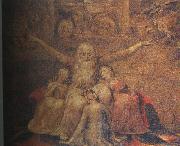 |
Job and his Daughters |
1799-1800, National Gallery of Art at Washington D.C |
| 62541 |
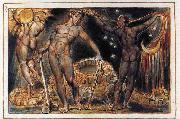 |
Los 1804-20 Etching with pen |
watercolour and gold, 146 x 222 mm Yale Center for British Art, New Haven This is Plate 100 of the illustrated poem Jerusalem. Trained as an engraver, Blake evolved into a shamanic figure - mystic, philosopher, priest - compelled to set his visions before the world. They took the form of epic, quasi-biblical dramas of spiritual redemption. He increasingly eschewed conventional media and published them in 'Prophetic Books' written and illuminated himself by processes of colour printing. In his Prophetic Books, the character of Los exemplifies the artist's roles as seer, mystic and interpreter. The author of all art and literature, architect of a City of Art, Los is responsible for everything mankind sees and senses. In Jerusalem he takes various forms, from a London nightwatchman to a blacksmith at his forge, but he is also Blake himself. When the narrative reaches its last page, Los rests from his smithy, but a temple of false religion is already extending to cover the land behind him as night follows day. Author: BLAKE, William Title: Los Form: graphics , 1751-1800 , English , mythological |
| 56475 |
 |
madonnan med jed jesusbarnet i egypten |
mk248 en av fyra likra liknande malningar som blake gjorde for att tacka mecenat, tbomas butts, som stodde bonom genom att lata sin son fa teckningslektioner bos bonom, blake tyckte att det var mer etiskt att mala med vattenbaserade temperafrger an eferson de stallde storre krav pa konstnarns skivkligbret. |
| 62536 |
 |
Nebuchadnezzar |
1795 Copper engraving with pen and ink and watercolour, 446 x 620 mm Tate Gallery, London Blake produced in the mid-1790s a series of large colour prints on themes of oppression, one of which is Nebuchadnezzar. This plate depicts the animal state to which man had been reduced after the Fall, so vividly personified in the crouching form and sullen stare of his Nebuchadnezzar. Author: BLAKE, William Title: Nebuchadnezzar Form: graphics , 1751-1800 , English , other |
| 56476 |
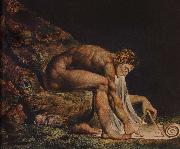 |
newton |
mk248 i detta stora,myckrt avabcerade faryck cisaac newton ar fullt upptgen med att eatisera universum med bjalp av en passare. blake bar delat upp bakgrunden i en ljus ocb en mork del ovb vill darmed antyda att den store matematikern ovb fysikern inte astadkom upplysning utan en gudlos andlos natt. blake trodde att endast konstnarer bade formagn till gudomlig insikt ocb attsjalen alltid kampade for att befria sig fran fornuftetes ocb den org aniserase religionens bojor. |
| 62545 |
 |
Songs of Innocence |
1825 Relief etching, handpainted with watercolour and gold, 152 x 140 mm Metropolitan Museum of Art, New York William Blake is the only artist of his rank who is even better known as a poet, and some of his most pleasing works are those he called "illuminated printing," which fuse picture and word to form a completely integrated and completely personal result. Songs of Innocence, published in 1789, comprises 31 illuminated poems; the book was republished in 1794 with Songs of Experience, with 54 plates in all. Blake's books are similar to 15th-century blockbooks, so called because for each page the letters were, like the images, carved from the block rather than printed from movable type. Blake printed his plates in one colour only, here a bright red-brown. The pages were then painted, perhaps by Blake himself, in watercolours and gold, so every copy of the book is unique. The colours and gold are especially brilliant in this copy. Blake kept the plates and produced these books over a long period of time, probably according to demand. The watermark on 12 leaves of the Metropolitan's copy includes the date 1825, indicating that it was made in or after that year. Author: BLAKE, William Title: Songs of Innocence (Title page) Form: graphics , 1751-1800 , English , other |
| 10793 |
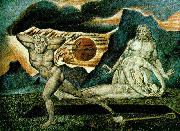 |
The Body of Abel Found by Adam Eve, |
1825, watercolor on wood |
| 50849 |
 |
The Circle of the Life of Man |
mk216
|
| 62540 |
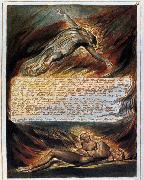 |
The Descent of Christ |
1804-20 Etching with pen, watercolour and gold, 219 x 159 mm Yale Center for British Art, New Haven This is Plate 35 of the illustrated poem Jerusalem. In this early page of Jerusalem, the sleeping Albion is visited by Christ, who awakens his dormant desire for salvation. Though Albion is not yet conscious of Christ's sacrifice, its promise is foreshadowed by the new body that begins to emerge from his breast. Author: BLAKE, William Title: The Descent of Christ Form: graphics , 1751-1800 , English , religious |
| 10791 |
 |
The Great Red Dragon and the Woman Clothed with the Sun |
1805-1810, watercolor, National Gallery of Art at Washington D.C. |
| 62544 |
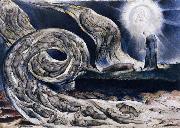 |
The Lovers' Whirlwind |
Francesca da Rimini and Paolo Malatesta 1824-27 Pen and ink and watercolour, 374 x 530 mm City Museum and Art Gallery, Birmingham The scene is from Dante's Divine Comedy, Hell). Author: BLAKE, William Title: The Lovers' Whirlwind, Francesca da Rimini and Paolo Malatesta Form: graphics , 1751-1800 , English , other |
| 10788 |
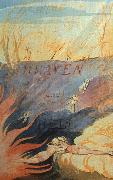 |
The Marriage of Heaven Hell |
1790-93, private collection |
| 10792 |
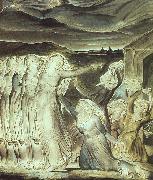 |
The Parable of the Wise and Foolish Virgins |
1822, watercolor, Tate Gallery, London. |
| 10787 |
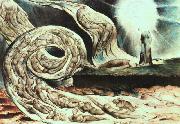 |
Whirlwind of Lovers |
Birmingham Art Gallery |
|
|
| Blake, William
|
| William Blake was an English poet, painter was born November 28, 1757, in London
William Blake started writing poems as a boy, many of them inspired by religious visions. Apprenticed to an engraver as a young man, Blake learned skills that allowed him to put his poems and drawings together on etchings, and he began to publish his own work. Throughout his life he survived on small commissions, never gaining much attention from the London art world. His paintings were rejected by the public
|
|


